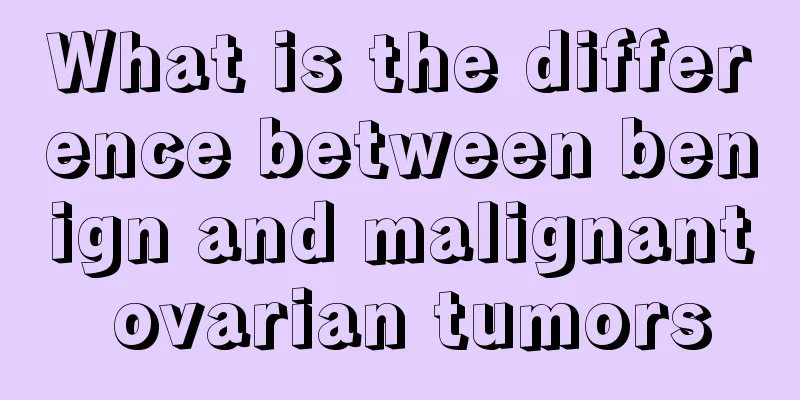What is the difference between benign and malignant ovarian tumors

|
Distinguishing whether an ovarian cyst is benign or malignant is the key to diagnosing and treating this type of tumor. Don't treat a benign tumor as a malignant tumor, which will bring a heavy mental burden to the patient and cause unnecessary pain; don't treat a malignant tumor as a benign tumor, which will delay the treatment and cause irreversible consequences. It is sometimes difficult to distinguish whether an ovarian cyst is benign or malignant, but the following points can be used for identification: *Medical history: patients with benign ovarian cysts have a long course of illness, the cysts gradually grow larger, and most have no discomfort symptoms; while patients with malignant ovarian cysts have a short course of illness, the cysts grow rapidly, and sometimes are accompanied by fever. *General situation: Benign cases mostly occur in women of childbearing age and are generally in good condition; while malignant cases mostly occur in prepubertal girls, teenagers or postmenopausal women. The disease progresses rapidly, with metastatic lesions in the early stages, and rapid appearance of malignant symptoms such as weight loss. *Physical signs: Benign cases are often unilateral, movable, with a smooth surface, intact capsule, cystic, and no ascites; while malignant cases are sometimes bilateral, immobile, often adhered to surrounding tissues, partially solid, with an uneven surface, and may penetrate the capsule and implant in the abdominal or pelvic cavity. Fixed nodules can be felt in the rectouterine pouch, often accompanied by bloody ascites. Cancer cells may be found during aspiration of the ascites. *B-ultrasound: Benign cases are mostly liquid dark areas with clear edges, while malignant cases have messy light clusters in the liquid dark areas and the boundaries of the tumor are unclear. *Tumor markers: Markers of malignant tumors can often be detected. *Pathological examination: The most important method of identification is to take the lesion tissue for pathological examination. You can take a biopsy of the lesion before surgery, or do a comprehensive pathological examination of the tumor removed during surgery. (Generally not done because it may cause the tumor to spread) Effective methods of treatment Once an ovarian cyst is diagnosed, surgery should be performed. Unless it is suspected to be a physiological cyst, short-term observation and follow-up can be performed. For benign ovarian cysts, doctors will decide the scope of surgery based on the patient's age, fertility requirements, and ovarian condition, and perform ovarian and salpingectomy or cystectomy. Even if the ovarian cysts are bilateral, cystectomy can be performed to preserve some normal ovarian tissue. The younger the patient, the more ovaries should be preserved. Women before and after menopause can undergo total hysterectomy and bilateral salpingectomy. If a malignant ovarian cyst is suspected, a laparotomy should be performed as soon as possible. Once it is confirmed to be a malignant tumor, in addition to removing the entire uterus and bilateral ovaries and fallopian tubes, retroperitoneal lymph node dissection should also be performed. After the operation, comprehensive treatment measures such as chemotherapy and radiotherapy should be added. |
>>: Detailed introduction to ovarian tumors
Recommend
What to do if urine iodine is high
Urinary iodine can reflect the iodine content in ...
What are the symptoms of advanced lung cancer before death?
Lung cancer is just a cough at the beginning, and...
How to boil quail eggs so they are easier to peel
Quail eggs are small in appearance and taste deli...
Side effects of radiation therapy
Nowadays, many cancer patients, regardless of whe...
Can corns grow on the palms of your hands?
Corns are a type of fleshy boil that grows on the...
What vegetables are easy to cause spots
I don’t know if you have noticed that there are m...
What are the obvious symptoms of high blood lipids
As they age, many people report high blood lipids...
Is rectal cancer soft or hard?
Is rectal cancer soft or hard? 1. Is rectal cance...
Smoking cures constipation
Many people think that smoking is a good way to t...
Why do my legs go numb after squatting for a while?
I believe that everyone has experienced the feeli...
Can anal fissures caused by dry stool be cured?
In life, many people will suffer from diseases in...
How does colon cancer develop? Doctor: This piece of extra flesh is the culprit
Intestinal cancer is not simply a cancer of the l...
The soles of my feet feel uncomfortable and I can't explain it
Many people experience discomfort in the soles of...
How long can you live with mid- to late-stage colorectal cancer
Intestinal cancer is a relatively serious digesti...
Redness on the roof of the mouth
In order to protect their oral cavity, many peopl...









